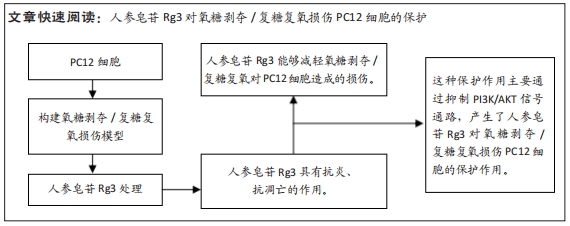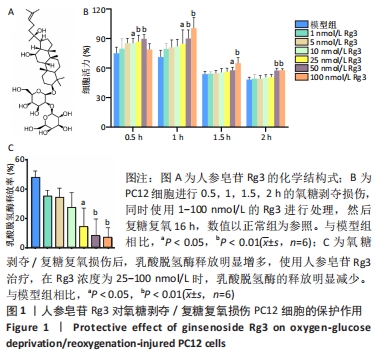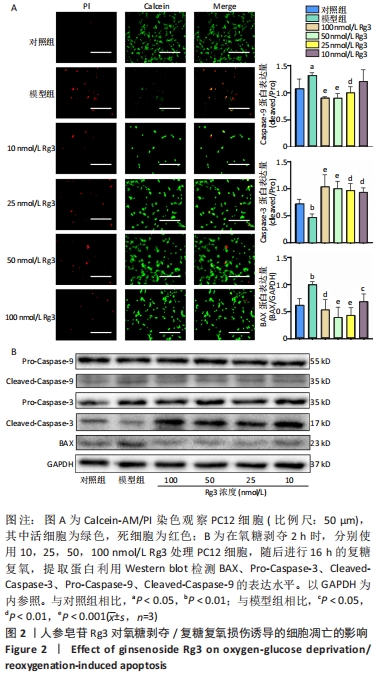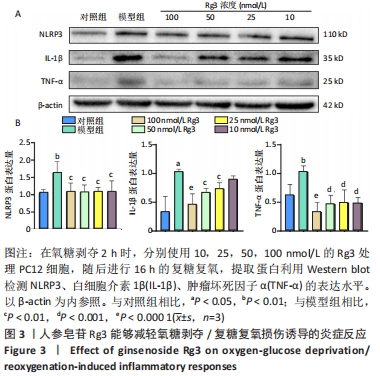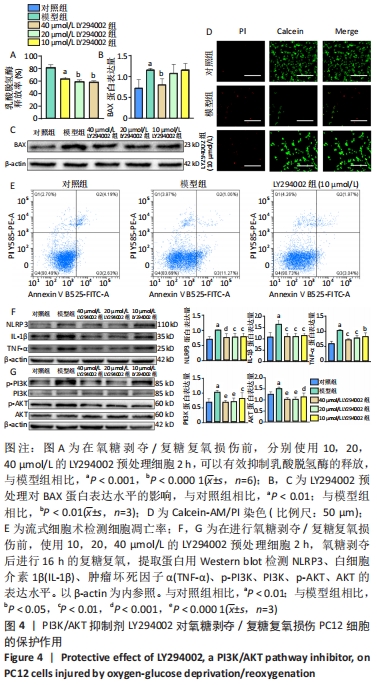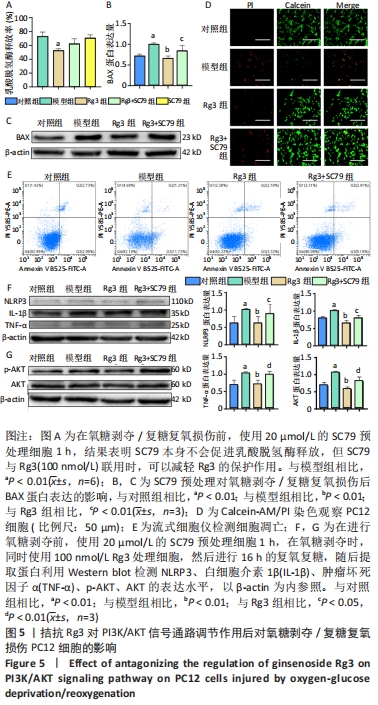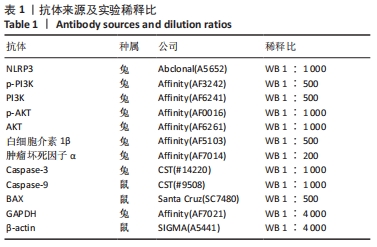[1] DONNAN GA, FISHER M, MACLEOD M, et al. Stroke. Lancet. 2008; 371(9624):1612-1623.
[2] MENON BK, CAMPBELL BC, LEVI C, et al. Role of imaging in current acute ischemic stroke workflow for endovascular therapy. Stroke. 2015; 46(6):1453-1461.
[3] ZHANG H, LIU X, YANG F, et al. Overexpression of HIF-1α protects PC12 cells against OGD/R-evoked injury by reducing miR-134 expression. Cell Cycle. 2020;19(9):990-999.
[4] LI S, SUN X, XU L, et al. Baicalin attenuates in vivo and in vitro hyperglycemia-exacerbated ischemia/reperfusion injury by regulating mitochondrial function in a manner dependent on AMPK. Eur J Pharmacol. 2017;815:118-126.
[5] REVATHIDEVI S, MUNIRAJAN AK. Akt in cancer: Mediator and more. Semin Cancer Biol. 2019;59:80-91.
[6] GABBOUJ S, RYHÄNEN S, MARTTINEN M, et al. Altered Insulin Signaling in Alzheimer’s Disease Brain - Special Emphasis on PI3K-Akt Pathway. Front Neurosci. 2019;13:629.
[7] KWON O, KIM KW, KIM MS. Leptin signalling pathways in hypothalamic neurons. Cell Mol Life Sci. 2016;73(7):1457-1477.
[8] ZHANG Z, YAO L, YANG J, et al. PI3K/Akt and HIF‑1 signaling pathway in hypoxia‑ischemia (Review). Mol Med Rep. 2018;18(4):3547-3554.
[9] 蔡苏娜,李强,周慧,等.白杨素通过抑制PI3K/AKT/mTOR信号通路发挥抗炎和抗氧化作用:基于蛋白质芯片方法[J].南方医科大学学报,2021,41(10):1554-1561.
[10] LI C, ZHAO B, LIN C, et al. TREM2 inhibits inflammatory responses in mouse microglia by suppressing the PI3K/NF-κB signaling. Cell Biol Int. 2019;43(4):360-372.
[11] WONG AS, CHE CM, LEUNG KW. Recent advances in ginseng as cancer therapeutics: a functional and mechanistic overview. Nat Prod Rep. 2015;32(2):256-272.
[12] WU W, SUN L, ZHANG Z, et al. Profiling and multivariate statistical analysis of Panax ginseng based on ultra-high-performance liquid chromatography coupled with quadrupole-time-of-flight mass spectrometry. J Pharm Biomed Anal. 2015;107:141-150.
[13] ATTELE AS, WU JA, YUAN CS. Ginseng pharmacology: multiple constituents and multiple actions. Biochem Pharmacol. 1999;58(11): 1685-1693.
[14] HE B, CHEN P, YANG J, et al. Neuroprotective effect of 20(R)-ginsenoside Rg(3) against transient focal cerebral ischemia in rats. Neurosci Lett. 2012;526(2):106-111.
[15] LIU H, LU X, HU Y, et al. Chemical constituents of Panax ginseng and Panax notoginseng explain why they differ in therapeutic efficacy. Pharmacol Res. 2020;161:105263.
[16] LEE H, KONG G, TRAN Q, et al. Relationship Between Ginsenoside Rg3 and Metabolic Syndrome. Front Pharmacol. 2020;11:130.
[17] CHENG Z, ZHANG M, LING C, et al. Neuroprotective Effects of Ginsenosides against Cerebral Ischemia. Molecules. 2019;24(6): 1102.
[18] BROUGHTON BR, REUTENS DC, SOBEY CG. Apoptotic mechanisms after cerebral ischemia. Stroke. 2009;40(5):e331-e339.
[19] CAMPANELLA M, SCIORATI C, TAROZZO G, et al. Flow cytometric analysis of inflammatory cells in ischemic rat brain. Stroke. 2002;33(2): 586-592.
[20] JIN R, LIU L, ZHANG S, et al. Role of inflammation and its mediators in acute ischemic stroke. J Cardiovasc Transl Res. 2013;6(5):834-851.
[21] GONG Z, PAN J, SHEN Q, et al. Mitochondrial dysfunction induces NLRP3 inflammasome activation during cerebral ischemia/reperfusion injury. J Neuroinflammation. 2018;15(1):242.
[22] WANG G, WANG T, ZHANG Y, et al. Schizandrin Protects against OGD/R-Induced Neuronal Injury by Suppressing Autophagy: Involvement of the AMPK/mTOR Pathway. Molecules. 2019;24(19):3624.
[23] JIA Y, CUI R, WANG C, et al. Metformin protects against intestinal ischemia-reperfusion injury and cell pyroptosis via TXNIP-NLRP3-GSDMD pathway. Redox Biol. 2020;32:101534.
[24] KIM S, KIM T, AHN K, et al. Ginsenoside Rg3 antagonizes NMDA receptors through a glycine modulatory site in rat cultured hippocampal neurons. Biochem Biophys Res Commun. 2004;323(2):416-424.
[25] SUN ZG, CHEN LP, WANG FW, et al. Protective effects of ginsenoside Rg1 against hydrogen peroxide-induced injury in human neuroblastoma cells. Neural Regen Res. 2016;11(7):1159-1164.
[26] FAN C, SONG Q, WANG P, et al. Neuroprotective Effects of Ginsenoside-Rg1 Against Depression-Like Behaviors via Suppressing Glial Activation, Synaptic Deficits, and Neuronal Apoptosis in Rats. Front Immunol. 2018;9:2889.
[27] CHO M, CHOI G, SHIM I, et al. Enhanced Rg3 negatively regulates Th1 cell responses. J Ginseng Res. 2019;43(1):49-57.
[28] SUN M, YE Y, XIAO L, et al. Anticancer effects of ginsenoside Rg3 (Review). Int J Mol Med. 2017;39(3):507-518.
[29] QIN XY, WANG YN, LIU HF, et al. Anti-cancer activities of metal-based complexes by regulating the VEGF/VEGFR2 signaling pathway and apoptosis-related factors Bcl-2, Bax, and caspase-9 to inhibit angiogenesis and induce apoptosis. Metallomics. 2020;12(1):92-103.
[30] BUDIHARDJO I, OLIVER H, LUTTER M, et al. Biochemical pathways of caspase activation during apoptosis. Annu Rev Cell Dev Biol. 1999; 15:269-290.
[31] BRENTNALL M, RODRIGUEZ-MENOCAL L, DE GUEVARA RL, et al. Caspase-9, caspase-3 and caspase-7 have distinct roles during intrinsic apoptosis. BMC Cell Biol. 2013;14:32.
[32] YUAN J, SHAHAM S, LEDOUX S, et al. The C. elegans cell death gene ced-3 encodes a protein similar to mammalian interleukin-1 beta-converting enzyme. Cell. 1993;75(4):641-652.
[33] PORTER AG, JÄNICKE RU. Emerging roles of caspase-3 in apoptosis. Cell Death Differ. 1999;6(2):99-104.
[34] LOSSI L, CASTAGNA C, MERIGHI A. Caspase-3 Mediated Cell Death in the Normal Development of the Mammalian Cerebellum. Int J Mol Sci. 2018;19(12):3999.
[35] POMPURA SL, DOMINGUEZ-VILLAR M. The PI3K/AKT signaling pathway in regulatory T-cell development, stability, and function. J Leukoc Biol. 2018;103:1065-1076.
[36] XU F, NA L, LI Y, et al. Roles of the PI3K/AKT/mTOR signalling pathways in neurodegenerative diseases and tumours. Cell Biosci. 2020;10(1):54.
[37] ZHANG J, ZHANG JX, ZHANG QL. PI3K/AKT/mTOR-mediated autophagy in the development of autism spectrum disorder. Brain Res Bull. 2016; 125:152-158.
[38] MANTHARI RK, TIKKA C, OMMATI MM, et al. Arsenic induces autophagy in developmental mouse cerebral cortex and hippocampus by inhibiting PI3K/Akt/mTOR signaling pathway: involvement of blood-brain barrier’s tight junction proteins. Arch Toxicol. 2018;92(11):3255-3275.
[39] GARABADU D, VERMA J. Exendin-4 attenuates brain mitochondrial toxicity through PI3K/Akt-dependent pathway in amyloid beta (1-42)-induced cognitive deficit rats. Neurochem Int. 2019;128:39-49.
[40] KITAGAWA H, WARITA H, SASAKI C, et al. Immunoreactive Akt, PI3-K and ERK protein kinase expression in ischemic rat brain. Neurosci Lett. 1999;274(1):45-48.
[41] ZHAO M, HOU S, FENG L, et al. Vinpocetine Protects Against Cerebral Ischemia-Reperfusion Injury by Targeting Astrocytic Connexin43 via the PI3K/AKT Signaling Pathway. Front Neurosci. 2020;14:223.
[42] JIN W, XU W, ZHANG X, et al. Ischemic Preconditioning Upregulates Decoy Receptors to Protect SH-SY5Y Cells from OGD Induced Cellular Damage by Inhibiting TRAIL Pathway and Agitating PI3K/Akt Pathway. Mol Neurobiol. 2020;57(9):3658-3670.
[43] WANG HL, LIU FL, LI RQ, et al. Electroacupuncture improves learning and memory functions in a rat cerebral ischemia/reperfusion injury model through PI3K/Akt signaling pathway activation. Neural Regen Res. 2021;16(6):1011-1016.
[44] CARPENTER CL, CANTLEY LC. Phosphoinositide kinases. Curr Opin Cell Biol. 1996;8(2):153-158.
[45] MOREIRA JB, WOHLWEND M, ALVES MN, et al. A small molecule activator of AKT does not reduce ischemic injury of the rat heart. J Transl Med. 2015;13:76.
|
